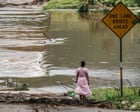
In recent days, the world has witnessed the disruptive power of nature as flash floods swept through parts of Texas and India, leading to severe consequences and testing the resilience of affected communities. The events, though geographically distant, serve as poignant reminders of the unpredictable challenges posed by extreme weather conditions.
In the heart of Texas, the Hill Country experienced unprecedented rainfall over a short period, culminating in devastating flash floods. Remnants of Tropical Storm Barry played a significant role in enhancing these storms, resulting in vast amounts of rain descending upon the region. Kerr County, in particular, bore the brunt of this natural fury, as over 300mm of rain fell in mere hours, creating perilous conditions that were difficult to foresee and manage.
By the end of the weekend, reports confirmed the tragic loss of life, with the death toll surpassing 100 people, and 28 girls from a nearby summer camp reported missing. The community of Kerr County, grappling with the aftermath, is now focusing on recovery and rebuilding efforts. As the impacted populations strive to reclaim a sense of normalcy, they share stories of escape and resilience amidst rapidly rising waters. The arrival of national figures and officials, including former President Donald Trump, underscores the attention this disaster has garnered, emphasizing both the immediate need for relief and the longer-term strategies for prevention and preparedness.
Meanwhile, on the other side of the globe, the Indian state of Himachal Pradesh has similarly faced nature’s ferocity in the form of intense rainfall, flash floods, and landslides. The geographical diversity of this mountainous region presents unique challenges when it comes to managing flood risks. The state saw numerous landslides and cloudbursts, where intense rain falls in a short period, contributing to the flood disasters. These events have severely disrupted life for the residents, with significant damage to homes, infrastructure, and essential services.
As families and local authorities assess the extensive damage, reports reveal that hundreds of homes, roads, bridges, and electricity pylons have been swept away, leaving many communities isolated and in urgent need of assistance. Efforts to locate and rescue missing persons continue with the mobilization of state resources and aid from the national government.
In both Texas and India, the immediate response has been crucial in providing aid and ensuring safety amid such crises. The coordinated efforts of local agencies, volunteers, and international aid initiatives have been vital. Furthermore, these events have fueled discussions on improving infrastructure resilience and developing more robust early-warning systems to mitigate the impacts of future natural disasters.
The recent floods in Texas and India highlight the shared vulnerability of communities across the globe to extreme weather events, emphasizing the need for comprehensive strategies to enhance preparedness and resilience. As the affected areas begin to heal and rebuild, there emerges a deeper recognition of the importance of community solidarity and international cooperation in facing such inevitable challenges.
Source: {link}
